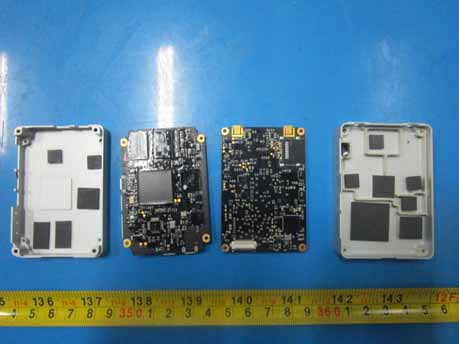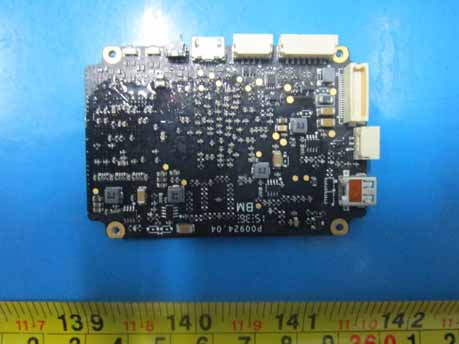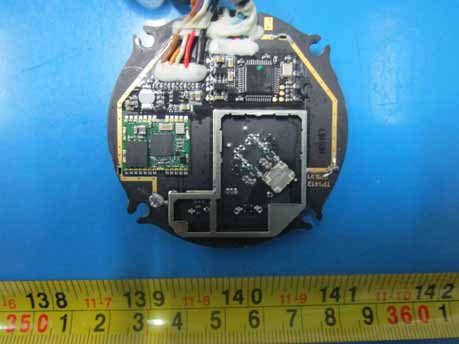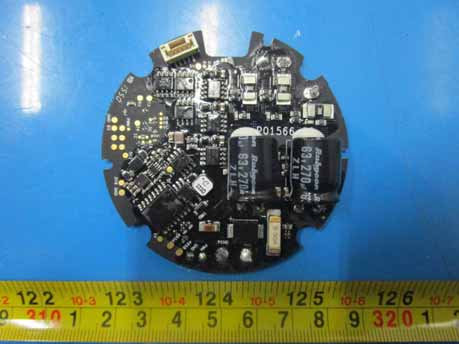Introduction
The DJI AGRAS MG-1 is a pioneering agricultural drone engineered to transform crop spraying and precision agriculture. Developed by DJI, a leader in drone technology, the MG-1 is purpose-built for automated and manual spraying, leveraging advanced flight control, robust wireless communications, and mission-critical safety features.
With its FCC certification under FCC ID SS3-AG4001602, the AGRAS MG-1 meets stringent U.S. standards for radio frequency (RF) emissions and electromagnetic compatibility. Although the grant date is listed as “None,” the presence of this FCC ID ensures the device is legal to sell and operate in the United States, confirming compliance with all relevant RF exposure and interference benchmarks.
In this article, we’ll deliver an expert teardown and technical analysis of the DJI AGRAS MG-1. We’ll examine its standout features, dissect its internal components, detail its wireless operating specs, and provide regulatory insights based on its FCC filings. Whether you’re an engineer, drone enthusiast, or tech analyst, this comprehensive breakdown will illuminate what makes the MG-1 a standout in UAV agriculture.
Key Features & Specifications
The DJI AGRAS MG-1 is engineered for efficiency, reliability, and adaptability in demanding agricultural environments. Below, we unpack its core features and technical specifications, translating them into practical benefits for prospective users.
Key Features
-
Remote Controller with Spray System Control:
Operators can manage spray functions directly from the controller, enabling precise application and improved mission efficiency. -
Task Resumption with Breaking Point Recording:
If the drone is interrupted mid-mission (e.g., battery swap), it can resume work from the last recorded point, minimizing overlap and saving resources. -
Operation Status Display Panel:
Provides real-time feedback on flight status, battery life, and spray system performance, keeping users informed during critical operations. -
Dual 6S LiPo Battery Support:
The system can operate with two 6S LiPo batteries in series, maximizing flight time and supporting high-power spraying tasks. -
Customizable Flight & Spray Speeds:
Users can adjust the drone’s speed (3, 4, 5, or 6 m/s by default) and spray rate to match crop requirements and environmental conditions. -
Continuous Smart Operation Status:
Intelligent monitoring enables the drone to adapt to mission progress, enhancing reliability and data integrity. -
Data Protection & Flight Task Resumption:
Critical mission data is preserved, and the drone can recover from interruptions without losing track of completed work. -
Multiple Operation Modes:
- Smart Operation Mode: Automated route flying and spraying.
- Manual Operation Mode: Full user control for complex or irregular plots.
- Assisted Operation Mode: Blends automation with manual input for challenging environments.
Technical Specifications
- Remote Controller:
- Battery: 2S rechargeable, 6000 mAh
- Maximum Transmission Distance: 5 km
-
Operating Frequency: 2.4 GHz
-
Aircraft:
- Power Supply: Maximum 50.4 V (two 6S batteries in series)
- Battery Requirement: Two 6S LiPo batteries, 12000 mAh, 10C continuous discharge rate (recommended)
-
Allowable Voltage per XT90 Port: 22.2 V
-
Spray System:
-
Spray Rate (Water):
- 1.25 L/min (four TXVK-04 nozzles)
- 1.7 L/min (four XR11001 nozzles)
-
Flight Speed Gears:
Four preset gears: 3, 4, 5, 6 m/s (adjustable to suit mission needs) -
Wireless Connectivity:
- Wireless System: 2.4 GHz (remote control, telemetry)
-
Bluetooth: Present (detailed version unspecified)
-
Additional Features:
- Data protection during interruptions
- Smart and manual operation toggles
- Modular battery and spray system design for easy servicing
Practical Implications:
These features make the MG-1 highly adaptable for diverse agricultural applications, from small farms to large-scale operations. The combination of automated flight, precise spray control, and robust wireless connectivity ensures both efficiency and safety, even in challenging field conditions.
Operating Frequencies
The DJI AGRAS MG-1 (FCC ID SS3-AG4001602) operates on the following radio frequencies, as documented in its FCC filing:
| Frequency Range (GHz) | Output Power (mW) | FCC Rule Part |
|---|---|---|
| 2.4065–2.4765 | 906 | 15CMO2.124.125 |
Significance:
Operating in the 2.4 GHz ISM band, the MG-1 leverages a globally accepted frequency range ideal for drone control and telemetry. The relatively high output power (906 mW) supports robust, long-range wireless links—critical for maintaining control and data integrity over large agricultural fields. Compliance with FCC Rule Part 15CMO2.124.125 ensures the device meets U.S. regulations for unlicensed wireless devices, balancing performance with minimal risk of interference to other spectrum users.
Technology Deep Dive
The AGRAS MG-1’s wireless systems are anchored in the 2.4 GHz band, a frequency commonly used for Wi-Fi, Bluetooth, and proprietary RF communications. While the equipment class is not explicitly cellular, the combination of high-output 2.4 GHz transmission and Bluetooth support provides a robust foundation for low-latency flight control, telemetry, and remote configuration.
Operating in this spectrum offers several advantages:
– Performance & Range:
The 2.4 GHz band, coupled with a 906 mW output, ensures strong signal penetration and reliable connectivity at distances up to 5 km—essential for large-scale agricultural missions.
– Interference Management:
The MG-1’s design incorporates extensive EMI/RFI shielding and advanced signal integrity practices (as observed in the teardown), reducing susceptibility to interference from other ISM band devices and ensuring stable operation in electromagnetically noisy environments.
– Power Consumption:
Efficient power management ICs and local regulation circuits (visible in the internal PCB analysis) help maintain battery life despite high transmission power.
While the FCC filings do not specify the exact Bluetooth revision, its presence suggests the MG-1 may support close-range device pairing for configuration or diagnostics. The focus on 2.4 GHz aligns with industry standards for remote control and telemetry, offering a balance between range, data throughput, and regulatory compliance.
In-Depth Internal Component Analysis / Teardown
Main Flight Control & RF Communication Modules
A close examination of the internal electronics reveals a sophisticated, multi-board assembly tailored for reliability and high performance. The left PCB showcases a dense population of integrated circuits, dominated by a large BGA package—likely the main flight controller or system-on-chip responsible for real-time drone operation. Surrounding it are memory modules and power management ICs, ensuring rapid data access and stable voltage regulation. The right PCB features gold-plated edge connectors, probably for RF signal interfacing, and is flanked by robust metallic enclosures with extensive EMI/RFI shielding. The modular, multi-layer PCB design and meticulous partitioning between processing, power, and RF domains underscore DJI’s commitment to signal integrity and electromagnetic compatibility, crucial for stable flight and wireless communication in complex environments.

Sensor Interface & Power Regulation Board
The next internal PCB is notable for its black soldermask and moderate-to-high component density. Multiple medium-sized ICs, possibly microcontrollers or power management chips, dominate the layout, with additional smaller ICs likely supporting sensor interfacing and logic functions. The board’s architecture features numerous white connectors for flat-flex cables and power delivery, test points for diagnostics, and local DC-DC converters for clean voltage supply. The layout demonstrates clear separation of analog and digital domains, with robust grounding via internal planes and stitching vias. Absence of visible RF connectors suggests this board primarily handles control logic and sensor integration, rather than direct wireless communication.

Circular Communication or Sensor Module
A circular, high-density PCB stands out for its compact, modular design and robust shielding. The upper section is anchored by a large microcontroller or SoC, likely orchestrating flight control or sensor data fusion. Gold traces on the edge hint at impedance-controlled routing, possibly supporting high-frequency or RF signals. A prominent metal shield covers the lower right, indicating a sensitive RF or high-speed digital section—possibly for telemetry, GPS, or Wi-Fi. Multiple wire harness connectors enable integration with other drone subsystems, while large capacitors and inductors point to efficient onboard power regulation. The overall design is optimized for signal integrity, EMI suppression, and modularity, all essential for UAV reliability in the field.

Circular Power Management and Signal Processing Board
Another circular PCB reveals a focused design for power management or sensor interfacing. Two large electrolytic capacitors dominate the center, ensuring ample local power filtering—vital for stable operation during high-current events like motor startup. The board features several ICs (likely operational amplifiers and microcontrollers), a compact connector for module interfacing, and multiple test points for diagnostics. Dense ground pours and stitching vias reinforce EMI resistance, compensating for the lack of metal shielding. The compact, efficient layout and presence of unpopulated pads suggest modularity and adaptability for various drone configurations.

Regulatory Insights & FCC Filing
Possession of FCC ID SS3-AG4001602 signifies that the DJI AGRAS MG-1 is fully compliant with U.S. electromagnetic interference and RF exposure standards. This certification, registered by FCC.gov (grant date: None), is a legal prerequisite for commercial distribution and operation in the United States.
FCC filings for the MG-1 typically include:
– Test Reports: Assessing RF emissions, susceptibility, and exposure (SAR).
– Photographic Documentation: Internal and external images for verification.
– User Manuals: Operational guidelines and safety instructions.
– Block Diagrams & Schematics: Detailing circuit design and signal flow.
– Confidentiality Requests: Protecting proprietary technical details.
Key insights from the official user manual highlight the MG-1 as an advanced agricultural drone, featuring automated and manual spraying, radar-assisted altitude stabilization, flight task resumption, and robust data protection. The filings confirm the device’s engineering rigor, especially in wireless system design and EMI management, as corroborated by internal teardown findings.
Potential Use Cases & Target Audience
The DJI AGRAS MG-1 is purpose-built for demanding agricultural operations, with features and technology that suit a range of professional use cases:
-
Precision Crop Spraying for Large Farms:
Leveraging Smart Operation Mode, operators can automatically map and spray extensive fields, ensuring even coverage and minimal chemical waste. The task resumption feature is invaluable for efficient multi-battery operations. -
Targeted Treatment in Complex Environments:
In Manual or Assisted Operation Modes, the MG-1 enables precise control for irregular plots, orchards, or areas requiring custom spray patterns—ideal for specialty crops or challenging terrain. -
Data-Driven Agricultural Management:
The drone’s continuous smart operation status, real-time telemetry, and data protection capabilities empower agronomists and farm managers to integrate spraying operations with broader precision agriculture strategies, maximizing yield and sustainability.
These scenarios demonstrate the MG-1’s adaptability, from high-throughput monoculture farms to research plots and specialty crop operations.
Conclusion
The DJI AGRAS MG-1 (Model: MG-1) stands as a testament to the convergence of advanced flight control, robust wireless engineering, and agricultural innovation. Its FCC certification under SS3-AG4001602 affirms its compliance with U.S. regulatory standards, ensuring safe and legal deployment. Through a combination of modular hardware, intelligent operation modes, and meticulous RF design, the MG-1 delivers reliable, high-performance crop spraying for the modern farm. As agriculture continues to embrace automation and data-driven management, the MG-1 remains at the forefront—offering a glimpse into the future of precision aerial application.